Risk Assessment Report: Property Millionaires Case Study Analysis
VerifiedAdded on 2022/12/23
|13
|3089
|68
Report
AI Summary
This report presents a comprehensive risk assessment of Property Millionaires, an Australian real estate mentoring service, based on a provided case study and the "How Risky is Your Company?" HBR article. The report analyzes the company's risk exposure across three key areas: pressure points due to growth (performance, expansion, and employee inexperience), culture (rewards, executive resistance, and internal competition), and information management (transaction complexity, diagnostic performance, and decision-making). The analysis utilizes a risk calculator to quantify the identified risks, providing scores for each pressure point. The report highlights specific issues within Property Millionaires, such as aggressive sales targets, rapid expansion without adequate employee experience, resistance to bad news, and unethical internal competition. The report concludes by summarizing the overall risk profile of the company and its implications for governance, ethics, and sustainability.
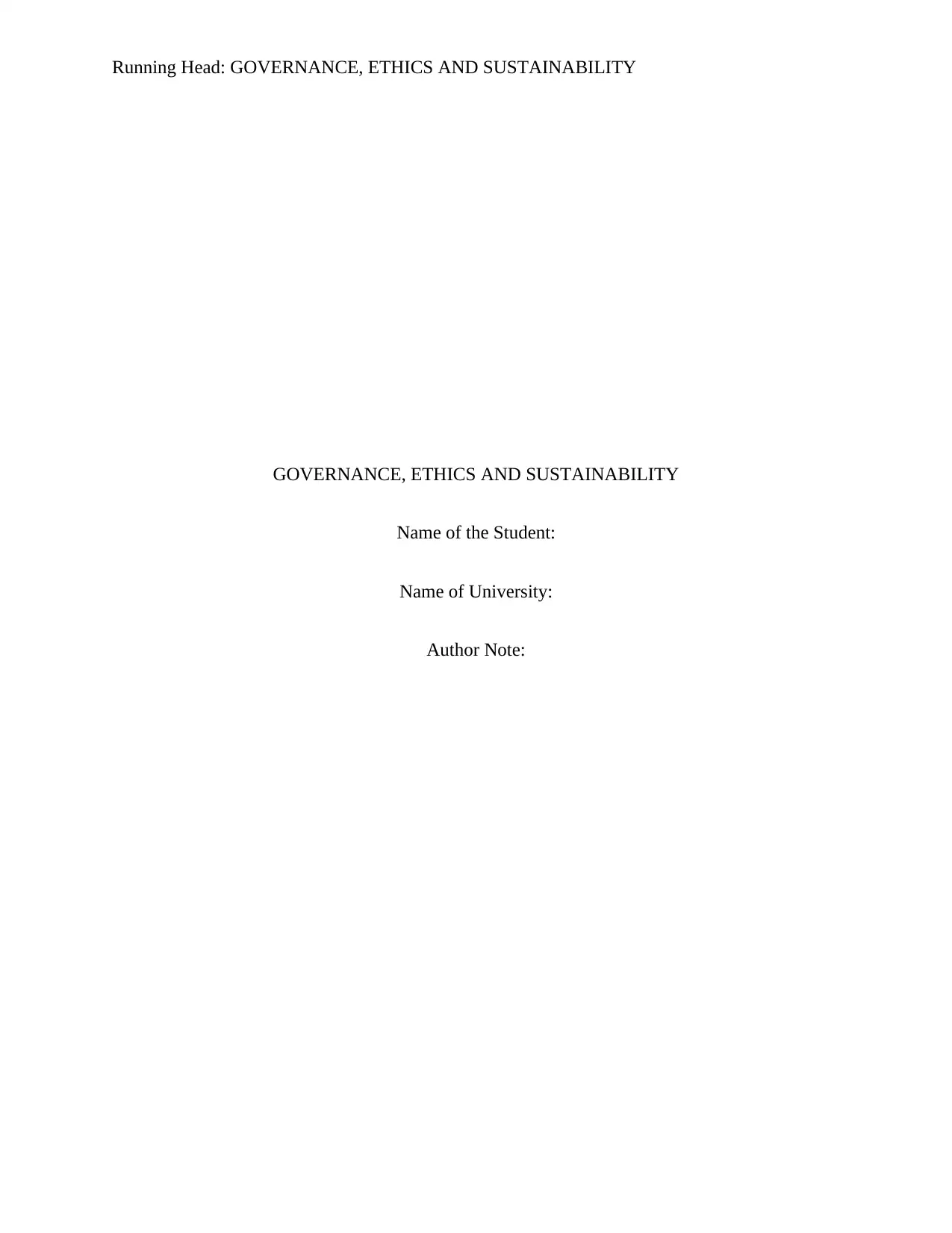
Running Head: GOVERNANCE, ETHICS AND SUSTAINABILITY
GOVERNANCE, ETHICS AND SUSTAINABILITY
Name of the Student:
Name of University:
Author Note:
GOVERNANCE, ETHICS AND SUSTAINABILITY
Name of the Student:
Name of University:
Author Note:
Paraphrase This Document
Need a fresh take? Get an instant paraphrase of this document with our AI Paraphraser
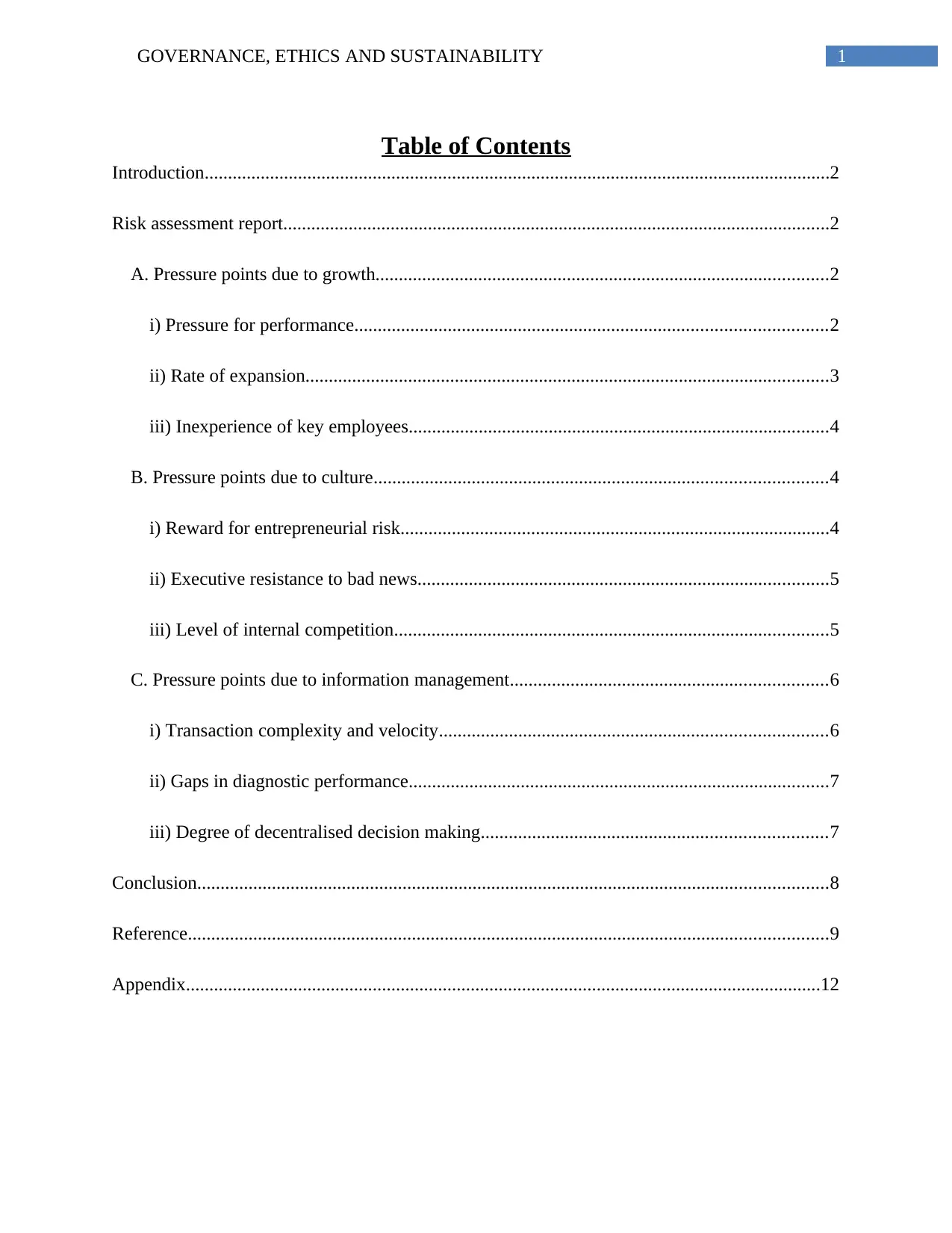
1GOVERNANCE, ETHICS AND SUSTAINABILITY
Table of Contents
Introduction......................................................................................................................................2
Risk assessment report.....................................................................................................................2
A. Pressure points due to growth.................................................................................................2
i) Pressure for performance.....................................................................................................2
ii) Rate of expansion................................................................................................................3
iii) Inexperience of key employees..........................................................................................4
B. Pressure points due to culture.................................................................................................4
i) Reward for entrepreneurial risk............................................................................................4
ii) Executive resistance to bad news........................................................................................5
iii) Level of internal competition.............................................................................................5
C. Pressure points due to information management....................................................................6
i) Transaction complexity and velocity...................................................................................6
ii) Gaps in diagnostic performance..........................................................................................7
iii) Degree of decentralised decision making..........................................................................7
Conclusion.......................................................................................................................................8
Reference.........................................................................................................................................9
Appendix........................................................................................................................................12
Table of Contents
Introduction......................................................................................................................................2
Risk assessment report.....................................................................................................................2
A. Pressure points due to growth.................................................................................................2
i) Pressure for performance.....................................................................................................2
ii) Rate of expansion................................................................................................................3
iii) Inexperience of key employees..........................................................................................4
B. Pressure points due to culture.................................................................................................4
i) Reward for entrepreneurial risk............................................................................................4
ii) Executive resistance to bad news........................................................................................5
iii) Level of internal competition.............................................................................................5
C. Pressure points due to information management....................................................................6
i) Transaction complexity and velocity...................................................................................6
ii) Gaps in diagnostic performance..........................................................................................7
iii) Degree of decentralised decision making..........................................................................7
Conclusion.......................................................................................................................................8
Reference.........................................................................................................................................9
Appendix........................................................................................................................................12
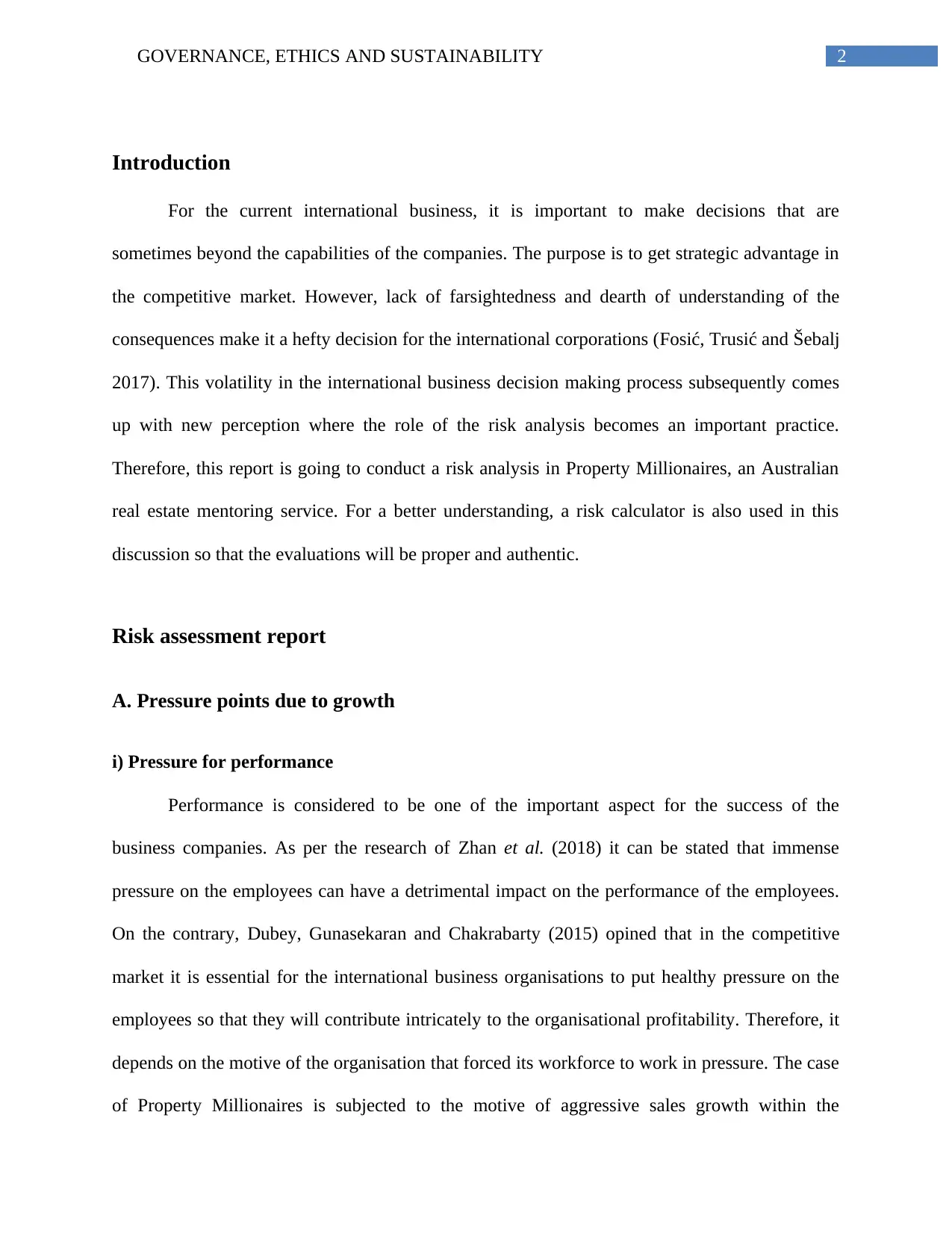
2GOVERNANCE, ETHICS AND SUSTAINABILITY
Introduction
For the current international business, it is important to make decisions that are
sometimes beyond the capabilities of the companies. The purpose is to get strategic advantage in
the competitive market. However, lack of farsightedness and dearth of understanding of the
consequences make it a hefty decision for the international corporations (Fosić, Trusić and Šebalj
2017). This volatility in the international business decision making process subsequently comes
up with new perception where the role of the risk analysis becomes an important practice.
Therefore, this report is going to conduct a risk analysis in Property Millionaires, an Australian
real estate mentoring service. For a better understanding, a risk calculator is also used in this
discussion so that the evaluations will be proper and authentic.
Risk assessment report
A. Pressure points due to growth
i) Pressure for performance
Performance is considered to be one of the important aspect for the success of the
business companies. As per the research of Zhan et al. (2018) it can be stated that immense
pressure on the employees can have a detrimental impact on the performance of the employees.
On the contrary, Dubey, Gunasekaran and Chakrabarty (2015) opined that in the competitive
market it is essential for the international business organisations to put healthy pressure on the
employees so that they will contribute intricately to the organisational profitability. Therefore, it
depends on the motive of the organisation that forced its workforce to work in pressure. The case
of Property Millionaires is subjected to the motive of aggressive sales growth within the
Introduction
For the current international business, it is important to make decisions that are
sometimes beyond the capabilities of the companies. The purpose is to get strategic advantage in
the competitive market. However, lack of farsightedness and dearth of understanding of the
consequences make it a hefty decision for the international corporations (Fosić, Trusić and Šebalj
2017). This volatility in the international business decision making process subsequently comes
up with new perception where the role of the risk analysis becomes an important practice.
Therefore, this report is going to conduct a risk analysis in Property Millionaires, an Australian
real estate mentoring service. For a better understanding, a risk calculator is also used in this
discussion so that the evaluations will be proper and authentic.
Risk assessment report
A. Pressure points due to growth
i) Pressure for performance
Performance is considered to be one of the important aspect for the success of the
business companies. As per the research of Zhan et al. (2018) it can be stated that immense
pressure on the employees can have a detrimental impact on the performance of the employees.
On the contrary, Dubey, Gunasekaran and Chakrabarty (2015) opined that in the competitive
market it is essential for the international business organisations to put healthy pressure on the
employees so that they will contribute intricately to the organisational profitability. Therefore, it
depends on the motive of the organisation that forced its workforce to work in pressure. The case
of Property Millionaires is subjected to the motive of aggressive sales growth within the
⊘ This is a preview!⊘
Do you want full access?
Subscribe today to unlock all pages.

Trusted by 1+ million students worldwide
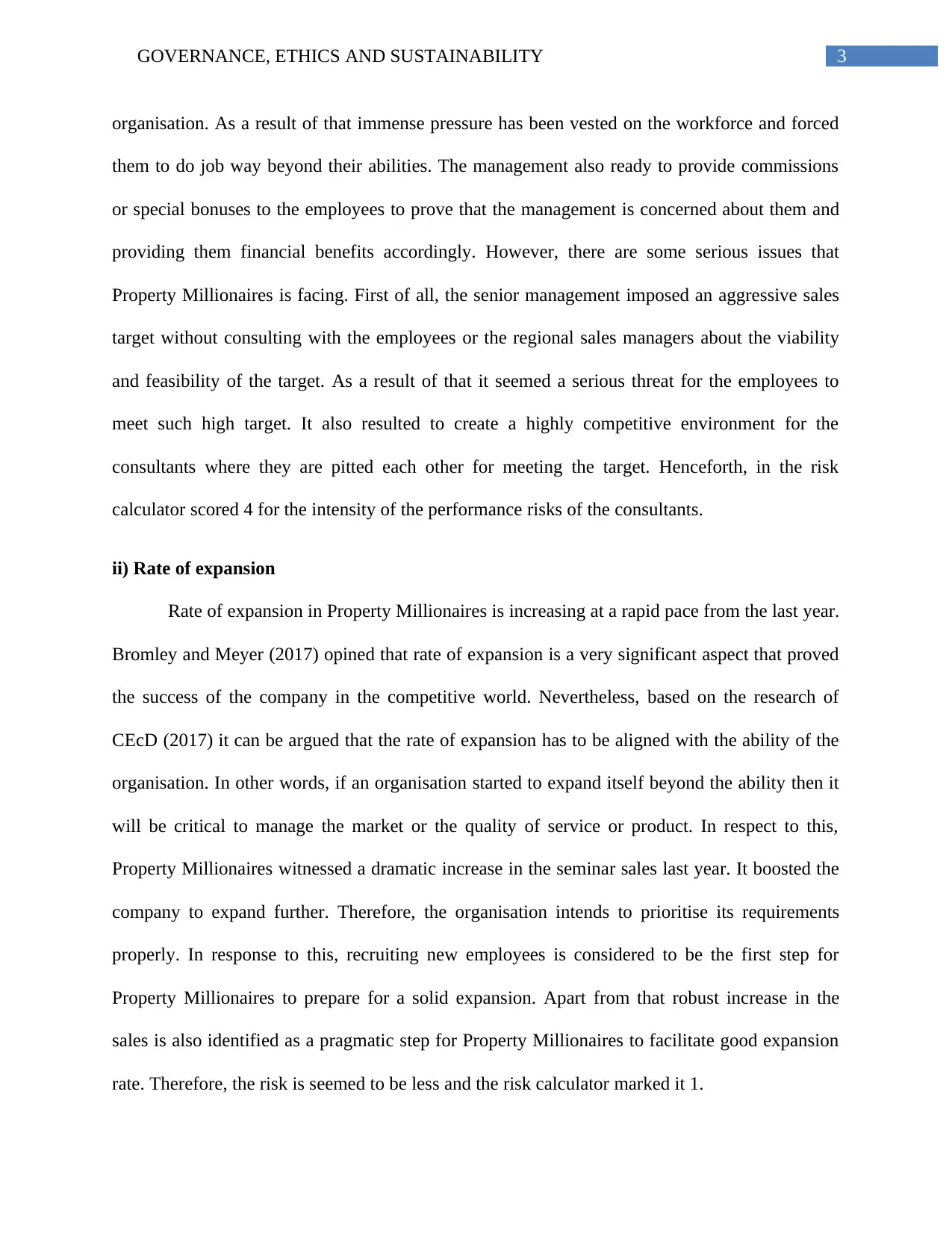
3GOVERNANCE, ETHICS AND SUSTAINABILITY
organisation. As a result of that immense pressure has been vested on the workforce and forced
them to do job way beyond their abilities. The management also ready to provide commissions
or special bonuses to the employees to prove that the management is concerned about them and
providing them financial benefits accordingly. However, there are some serious issues that
Property Millionaires is facing. First of all, the senior management imposed an aggressive sales
target without consulting with the employees or the regional sales managers about the viability
and feasibility of the target. As a result of that it seemed a serious threat for the employees to
meet such high target. It also resulted to create a highly competitive environment for the
consultants where they are pitted each other for meeting the target. Henceforth, in the risk
calculator scored 4 for the intensity of the performance risks of the consultants.
ii) Rate of expansion
Rate of expansion in Property Millionaires is increasing at a rapid pace from the last year.
Bromley and Meyer (2017) opined that rate of expansion is a very significant aspect that proved
the success of the company in the competitive world. Nevertheless, based on the research of
CEcD (2017) it can be argued that the rate of expansion has to be aligned with the ability of the
organisation. In other words, if an organisation started to expand itself beyond the ability then it
will be critical to manage the market or the quality of service or product. In respect to this,
Property Millionaires witnessed a dramatic increase in the seminar sales last year. It boosted the
company to expand further. Therefore, the organisation intends to prioritise its requirements
properly. In response to this, recruiting new employees is considered to be the first step for
Property Millionaires to prepare for a solid expansion. Apart from that robust increase in the
sales is also identified as a pragmatic step for Property Millionaires to facilitate good expansion
rate. Therefore, the risk is seemed to be less and the risk calculator marked it 1.
organisation. As a result of that immense pressure has been vested on the workforce and forced
them to do job way beyond their abilities. The management also ready to provide commissions
or special bonuses to the employees to prove that the management is concerned about them and
providing them financial benefits accordingly. However, there are some serious issues that
Property Millionaires is facing. First of all, the senior management imposed an aggressive sales
target without consulting with the employees or the regional sales managers about the viability
and feasibility of the target. As a result of that it seemed a serious threat for the employees to
meet such high target. It also resulted to create a highly competitive environment for the
consultants where they are pitted each other for meeting the target. Henceforth, in the risk
calculator scored 4 for the intensity of the performance risks of the consultants.
ii) Rate of expansion
Rate of expansion in Property Millionaires is increasing at a rapid pace from the last year.
Bromley and Meyer (2017) opined that rate of expansion is a very significant aspect that proved
the success of the company in the competitive world. Nevertheless, based on the research of
CEcD (2017) it can be argued that the rate of expansion has to be aligned with the ability of the
organisation. In other words, if an organisation started to expand itself beyond the ability then it
will be critical to manage the market or the quality of service or product. In respect to this,
Property Millionaires witnessed a dramatic increase in the seminar sales last year. It boosted the
company to expand further. Therefore, the organisation intends to prioritise its requirements
properly. In response to this, recruiting new employees is considered to be the first step for
Property Millionaires to prepare for a solid expansion. Apart from that robust increase in the
sales is also identified as a pragmatic step for Property Millionaires to facilitate good expansion
rate. Therefore, the risk is seemed to be less and the risk calculator marked it 1.
Paraphrase This Document
Need a fresh take? Get an instant paraphrase of this document with our AI Paraphraser
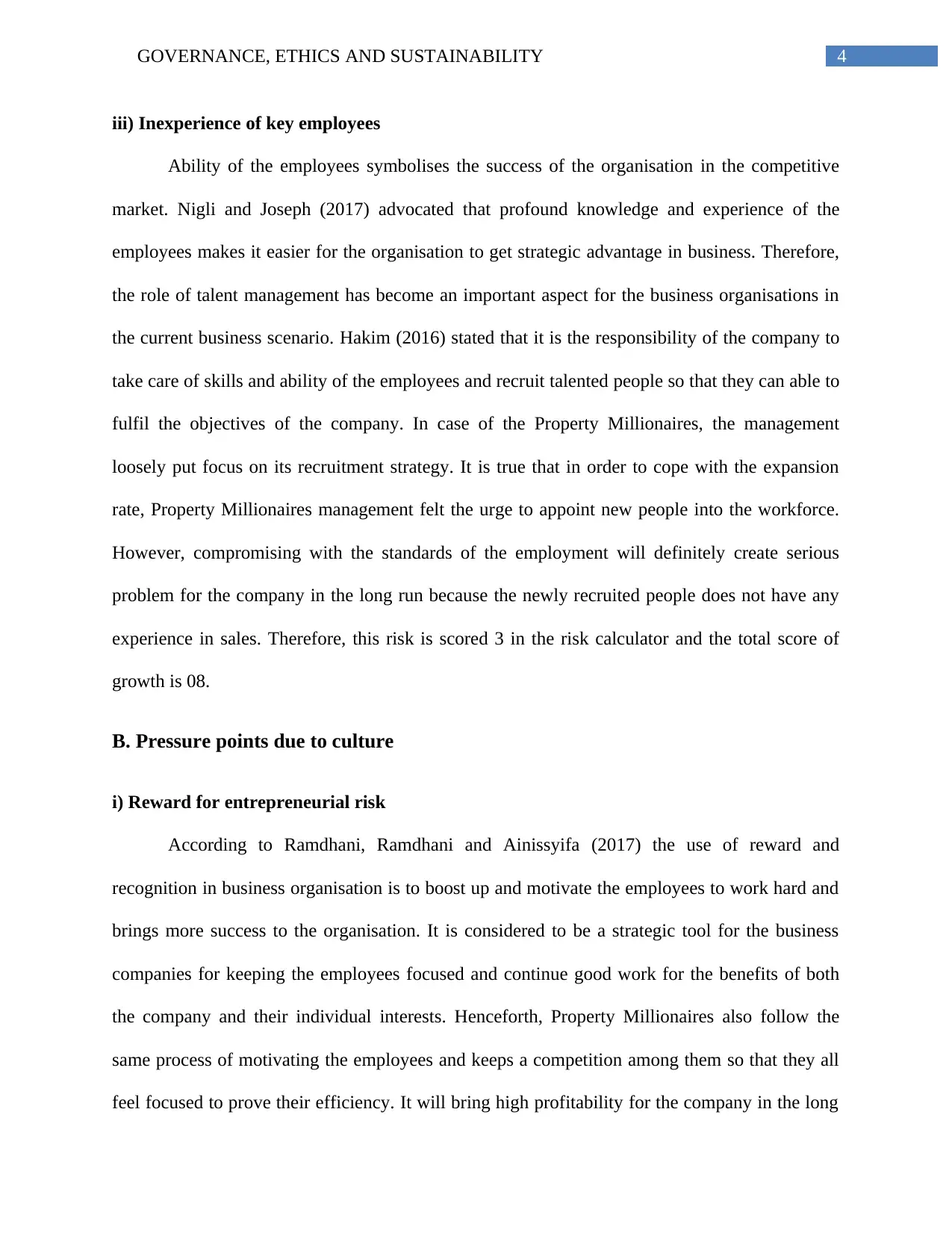
4GOVERNANCE, ETHICS AND SUSTAINABILITY
iii) Inexperience of key employees
Ability of the employees symbolises the success of the organisation in the competitive
market. Nigli and Joseph (2017) advocated that profound knowledge and experience of the
employees makes it easier for the organisation to get strategic advantage in business. Therefore,
the role of talent management has become an important aspect for the business organisations in
the current business scenario. Hakim (2016) stated that it is the responsibility of the company to
take care of skills and ability of the employees and recruit talented people so that they can able to
fulfil the objectives of the company. In case of the Property Millionaires, the management
loosely put focus on its recruitment strategy. It is true that in order to cope with the expansion
rate, Property Millionaires management felt the urge to appoint new people into the workforce.
However, compromising with the standards of the employment will definitely create serious
problem for the company in the long run because the newly recruited people does not have any
experience in sales. Therefore, this risk is scored 3 in the risk calculator and the total score of
growth is 08.
B. Pressure points due to culture
i) Reward for entrepreneurial risk
According to Ramdhani, Ramdhani and Ainissyifa (2017) the use of reward and
recognition in business organisation is to boost up and motivate the employees to work hard and
brings more success to the organisation. It is considered to be a strategic tool for the business
companies for keeping the employees focused and continue good work for the benefits of both
the company and their individual interests. Henceforth, Property Millionaires also follow the
same process of motivating the employees and keeps a competition among them so that they all
feel focused to prove their efficiency. It will bring high profitability for the company in the long
iii) Inexperience of key employees
Ability of the employees symbolises the success of the organisation in the competitive
market. Nigli and Joseph (2017) advocated that profound knowledge and experience of the
employees makes it easier for the organisation to get strategic advantage in business. Therefore,
the role of talent management has become an important aspect for the business organisations in
the current business scenario. Hakim (2016) stated that it is the responsibility of the company to
take care of skills and ability of the employees and recruit talented people so that they can able to
fulfil the objectives of the company. In case of the Property Millionaires, the management
loosely put focus on its recruitment strategy. It is true that in order to cope with the expansion
rate, Property Millionaires management felt the urge to appoint new people into the workforce.
However, compromising with the standards of the employment will definitely create serious
problem for the company in the long run because the newly recruited people does not have any
experience in sales. Therefore, this risk is scored 3 in the risk calculator and the total score of
growth is 08.
B. Pressure points due to culture
i) Reward for entrepreneurial risk
According to Ramdhani, Ramdhani and Ainissyifa (2017) the use of reward and
recognition in business organisation is to boost up and motivate the employees to work hard and
brings more success to the organisation. It is considered to be a strategic tool for the business
companies for keeping the employees focused and continue good work for the benefits of both
the company and their individual interests. Henceforth, Property Millionaires also follow the
same process of motivating the employees and keeps a competition among them so that they all
feel focused to prove their efficiency. It will bring high profitability for the company in the long
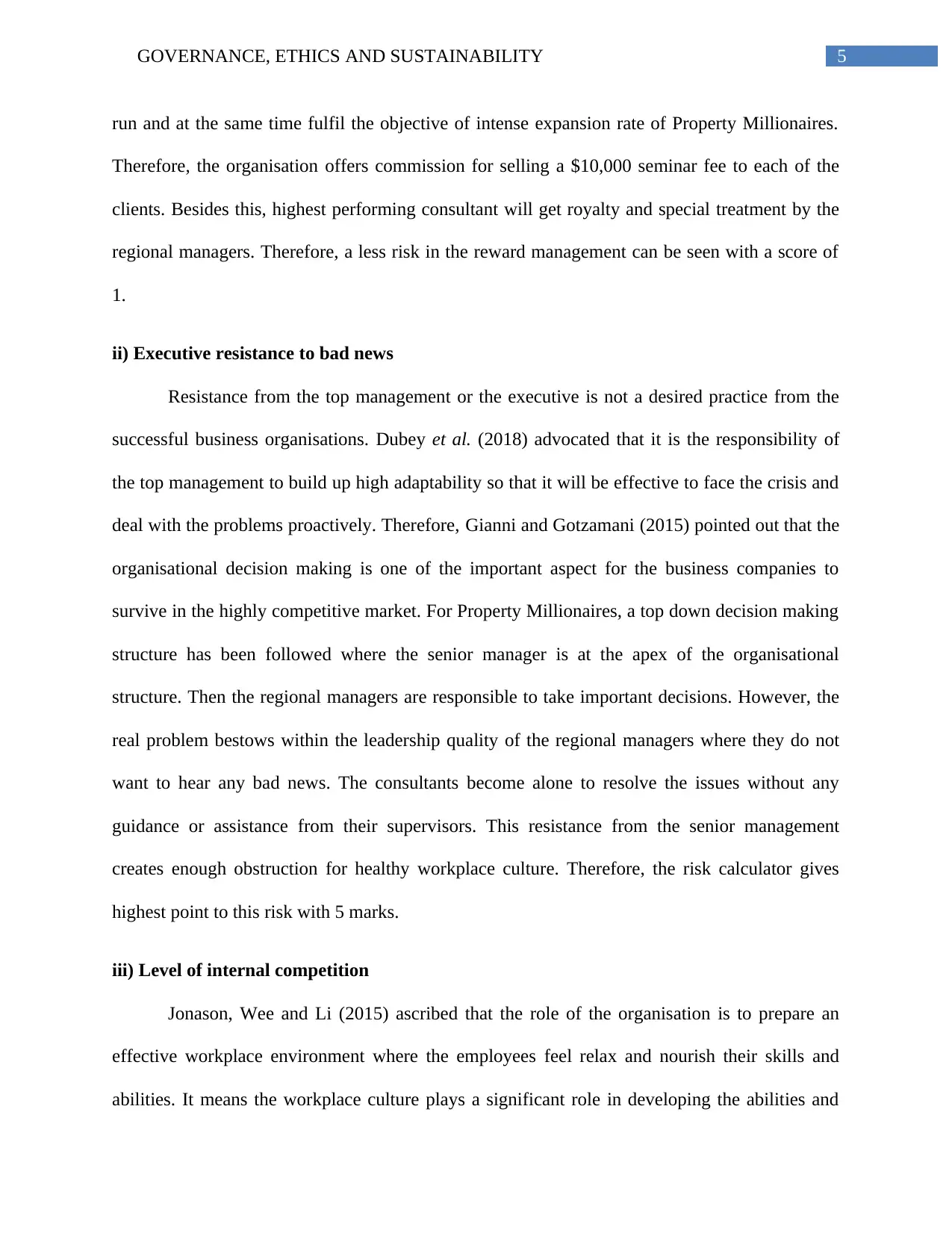
5GOVERNANCE, ETHICS AND SUSTAINABILITY
run and at the same time fulfil the objective of intense expansion rate of Property Millionaires.
Therefore, the organisation offers commission for selling a $10,000 seminar fee to each of the
clients. Besides this, highest performing consultant will get royalty and special treatment by the
regional managers. Therefore, a less risk in the reward management can be seen with a score of
1.
ii) Executive resistance to bad news
Resistance from the top management or the executive is not a desired practice from the
successful business organisations. Dubey et al. (2018) advocated that it is the responsibility of
the top management to build up high adaptability so that it will be effective to face the crisis and
deal with the problems proactively. Therefore, Gianni and Gotzamani (2015) pointed out that the
organisational decision making is one of the important aspect for the business companies to
survive in the highly competitive market. For Property Millionaires, a top down decision making
structure has been followed where the senior manager is at the apex of the organisational
structure. Then the regional managers are responsible to take important decisions. However, the
real problem bestows within the leadership quality of the regional managers where they do not
want to hear any bad news. The consultants become alone to resolve the issues without any
guidance or assistance from their supervisors. This resistance from the senior management
creates enough obstruction for healthy workplace culture. Therefore, the risk calculator gives
highest point to this risk with 5 marks.
iii) Level of internal competition
Jonason, Wee and Li (2015) ascribed that the role of the organisation is to prepare an
effective workplace environment where the employees feel relax and nourish their skills and
abilities. It means the workplace culture plays a significant role in developing the abilities and
run and at the same time fulfil the objective of intense expansion rate of Property Millionaires.
Therefore, the organisation offers commission for selling a $10,000 seminar fee to each of the
clients. Besides this, highest performing consultant will get royalty and special treatment by the
regional managers. Therefore, a less risk in the reward management can be seen with a score of
1.
ii) Executive resistance to bad news
Resistance from the top management or the executive is not a desired practice from the
successful business organisations. Dubey et al. (2018) advocated that it is the responsibility of
the top management to build up high adaptability so that it will be effective to face the crisis and
deal with the problems proactively. Therefore, Gianni and Gotzamani (2015) pointed out that the
organisational decision making is one of the important aspect for the business companies to
survive in the highly competitive market. For Property Millionaires, a top down decision making
structure has been followed where the senior manager is at the apex of the organisational
structure. Then the regional managers are responsible to take important decisions. However, the
real problem bestows within the leadership quality of the regional managers where they do not
want to hear any bad news. The consultants become alone to resolve the issues without any
guidance or assistance from their supervisors. This resistance from the senior management
creates enough obstruction for healthy workplace culture. Therefore, the risk calculator gives
highest point to this risk with 5 marks.
iii) Level of internal competition
Jonason, Wee and Li (2015) ascribed that the role of the organisation is to prepare an
effective workplace environment where the employees feel relax and nourish their skills and
abilities. It means the workplace culture plays a significant role in developing the abilities and
⊘ This is a preview!⊘
Do you want full access?
Subscribe today to unlock all pages.

Trusted by 1+ million students worldwide
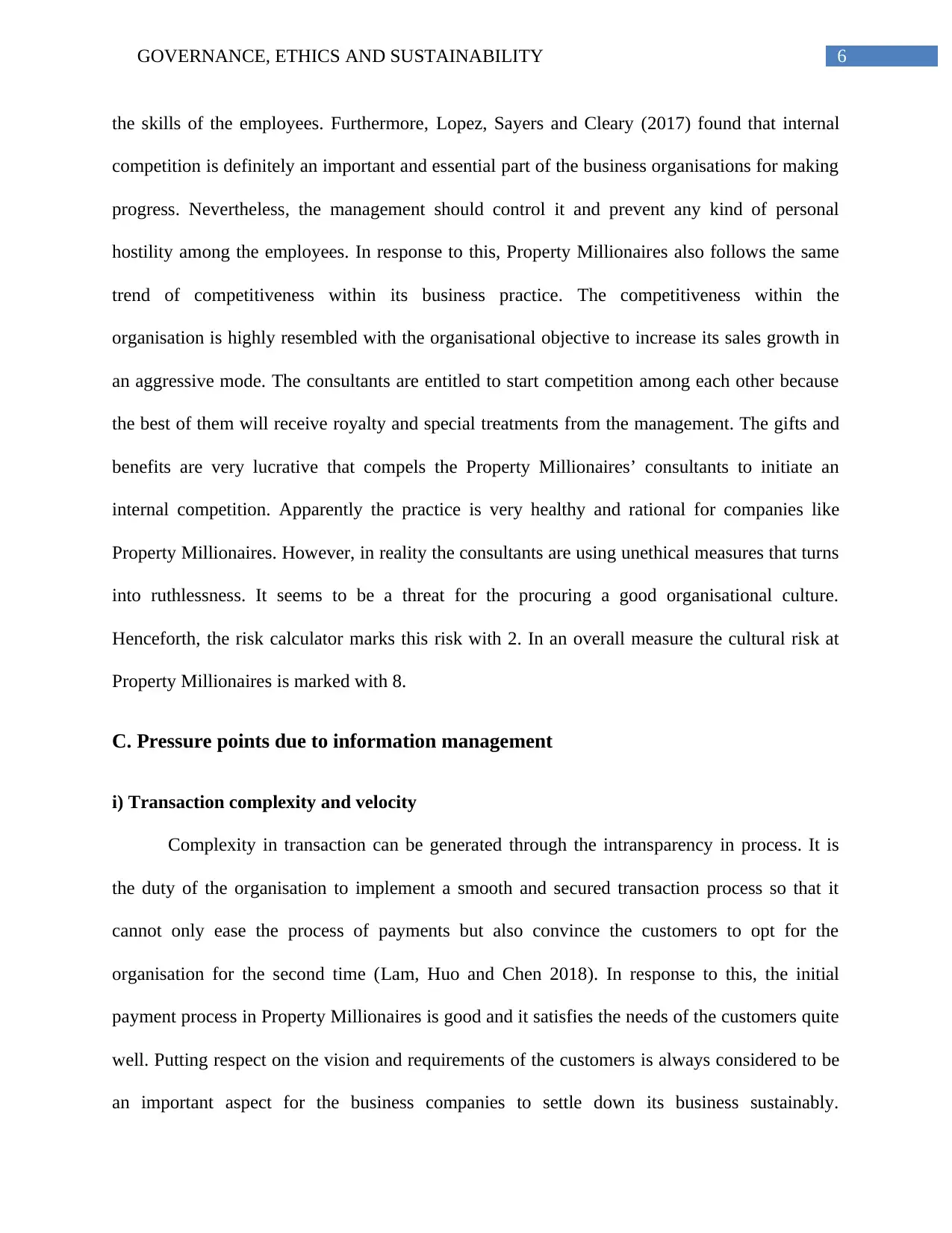
6GOVERNANCE, ETHICS AND SUSTAINABILITY
the skills of the employees. Furthermore, Lopez, Sayers and Cleary (2017) found that internal
competition is definitely an important and essential part of the business organisations for making
progress. Nevertheless, the management should control it and prevent any kind of personal
hostility among the employees. In response to this, Property Millionaires also follows the same
trend of competitiveness within its business practice. The competitiveness within the
organisation is highly resembled with the organisational objective to increase its sales growth in
an aggressive mode. The consultants are entitled to start competition among each other because
the best of them will receive royalty and special treatments from the management. The gifts and
benefits are very lucrative that compels the Property Millionaires’ consultants to initiate an
internal competition. Apparently the practice is very healthy and rational for companies like
Property Millionaires. However, in reality the consultants are using unethical measures that turns
into ruthlessness. It seems to be a threat for the procuring a good organisational culture.
Henceforth, the risk calculator marks this risk with 2. In an overall measure the cultural risk at
Property Millionaires is marked with 8.
C. Pressure points due to information management
i) Transaction complexity and velocity
Complexity in transaction can be generated through the intransparency in process. It is
the duty of the organisation to implement a smooth and secured transaction process so that it
cannot only ease the process of payments but also convince the customers to opt for the
organisation for the second time (Lam, Huo and Chen 2018). In response to this, the initial
payment process in Property Millionaires is good and it satisfies the needs of the customers quite
well. Putting respect on the vision and requirements of the customers is always considered to be
an important aspect for the business companies to settle down its business sustainably.
the skills of the employees. Furthermore, Lopez, Sayers and Cleary (2017) found that internal
competition is definitely an important and essential part of the business organisations for making
progress. Nevertheless, the management should control it and prevent any kind of personal
hostility among the employees. In response to this, Property Millionaires also follows the same
trend of competitiveness within its business practice. The competitiveness within the
organisation is highly resembled with the organisational objective to increase its sales growth in
an aggressive mode. The consultants are entitled to start competition among each other because
the best of them will receive royalty and special treatments from the management. The gifts and
benefits are very lucrative that compels the Property Millionaires’ consultants to initiate an
internal competition. Apparently the practice is very healthy and rational for companies like
Property Millionaires. However, in reality the consultants are using unethical measures that turns
into ruthlessness. It seems to be a threat for the procuring a good organisational culture.
Henceforth, the risk calculator marks this risk with 2. In an overall measure the cultural risk at
Property Millionaires is marked with 8.
C. Pressure points due to information management
i) Transaction complexity and velocity
Complexity in transaction can be generated through the intransparency in process. It is
the duty of the organisation to implement a smooth and secured transaction process so that it
cannot only ease the process of payments but also convince the customers to opt for the
organisation for the second time (Lam, Huo and Chen 2018). In response to this, the initial
payment process in Property Millionaires is good and it satisfies the needs of the customers quite
well. Putting respect on the vision and requirements of the customers is always considered to be
an important aspect for the business companies to settle down its business sustainably.
Paraphrase This Document
Need a fresh take? Get an instant paraphrase of this document with our AI Paraphraser
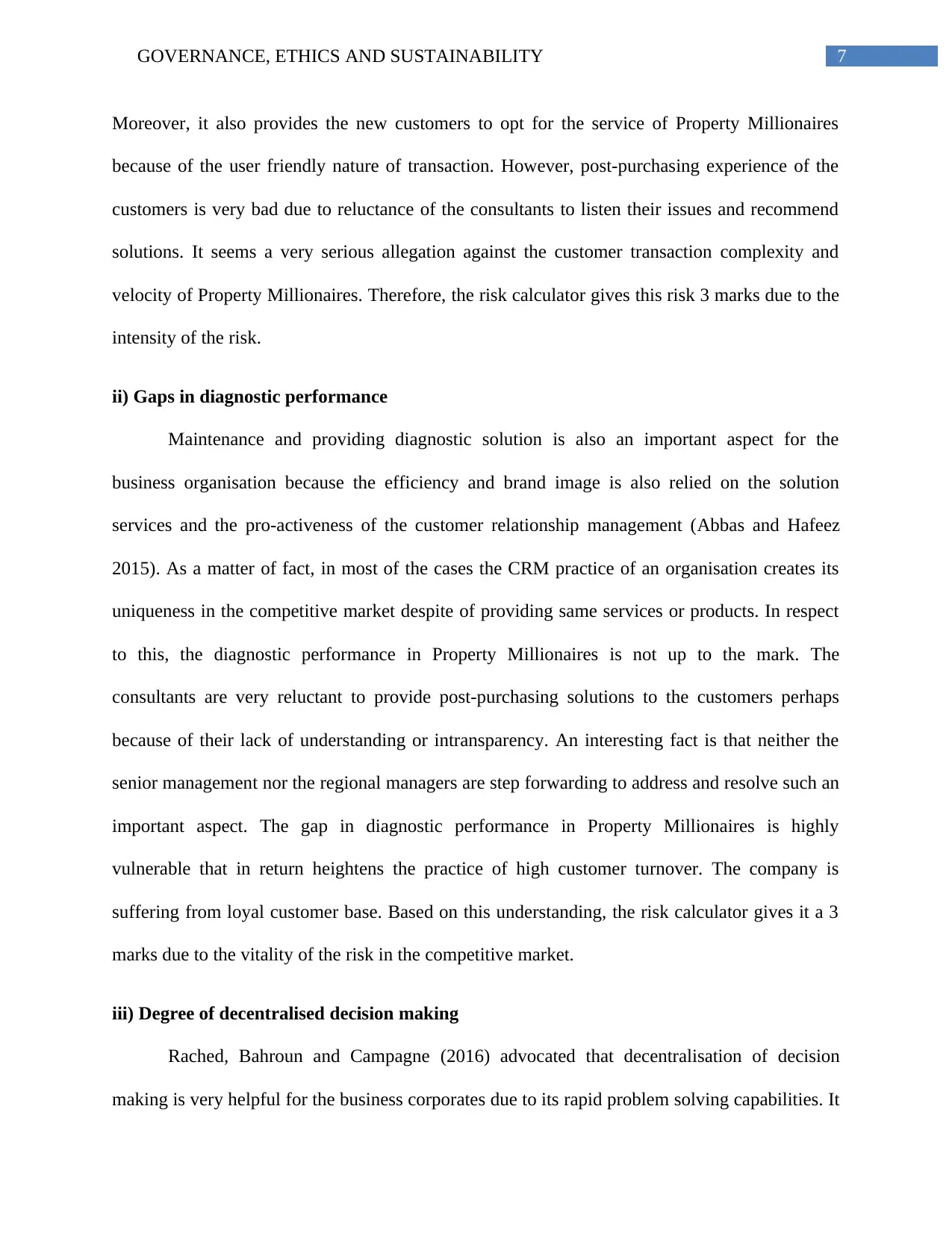
7GOVERNANCE, ETHICS AND SUSTAINABILITY
Moreover, it also provides the new customers to opt for the service of Property Millionaires
because of the user friendly nature of transaction. However, post-purchasing experience of the
customers is very bad due to reluctance of the consultants to listen their issues and recommend
solutions. It seems a very serious allegation against the customer transaction complexity and
velocity of Property Millionaires. Therefore, the risk calculator gives this risk 3 marks due to the
intensity of the risk.
ii) Gaps in diagnostic performance
Maintenance and providing diagnostic solution is also an important aspect for the
business organisation because the efficiency and brand image is also relied on the solution
services and the pro-activeness of the customer relationship management (Abbas and Hafeez
2015). As a matter of fact, in most of the cases the CRM practice of an organisation creates its
uniqueness in the competitive market despite of providing same services or products. In respect
to this, the diagnostic performance in Property Millionaires is not up to the mark. The
consultants are very reluctant to provide post-purchasing solutions to the customers perhaps
because of their lack of understanding or intransparency. An interesting fact is that neither the
senior management nor the regional managers are step forwarding to address and resolve such an
important aspect. The gap in diagnostic performance in Property Millionaires is highly
vulnerable that in return heightens the practice of high customer turnover. The company is
suffering from loyal customer base. Based on this understanding, the risk calculator gives it a 3
marks due to the vitality of the risk in the competitive market.
iii) Degree of decentralised decision making
Rached, Bahroun and Campagne (2016) advocated that decentralisation of decision
making is very helpful for the business corporates due to its rapid problem solving capabilities. It
Moreover, it also provides the new customers to opt for the service of Property Millionaires
because of the user friendly nature of transaction. However, post-purchasing experience of the
customers is very bad due to reluctance of the consultants to listen their issues and recommend
solutions. It seems a very serious allegation against the customer transaction complexity and
velocity of Property Millionaires. Therefore, the risk calculator gives this risk 3 marks due to the
intensity of the risk.
ii) Gaps in diagnostic performance
Maintenance and providing diagnostic solution is also an important aspect for the
business organisation because the efficiency and brand image is also relied on the solution
services and the pro-activeness of the customer relationship management (Abbas and Hafeez
2015). As a matter of fact, in most of the cases the CRM practice of an organisation creates its
uniqueness in the competitive market despite of providing same services or products. In respect
to this, the diagnostic performance in Property Millionaires is not up to the mark. The
consultants are very reluctant to provide post-purchasing solutions to the customers perhaps
because of their lack of understanding or intransparency. An interesting fact is that neither the
senior management nor the regional managers are step forwarding to address and resolve such an
important aspect. The gap in diagnostic performance in Property Millionaires is highly
vulnerable that in return heightens the practice of high customer turnover. The company is
suffering from loyal customer base. Based on this understanding, the risk calculator gives it a 3
marks due to the vitality of the risk in the competitive market.
iii) Degree of decentralised decision making
Rached, Bahroun and Campagne (2016) advocated that decentralisation of decision
making is very helpful for the business corporates due to its rapid problem solving capabilities. It
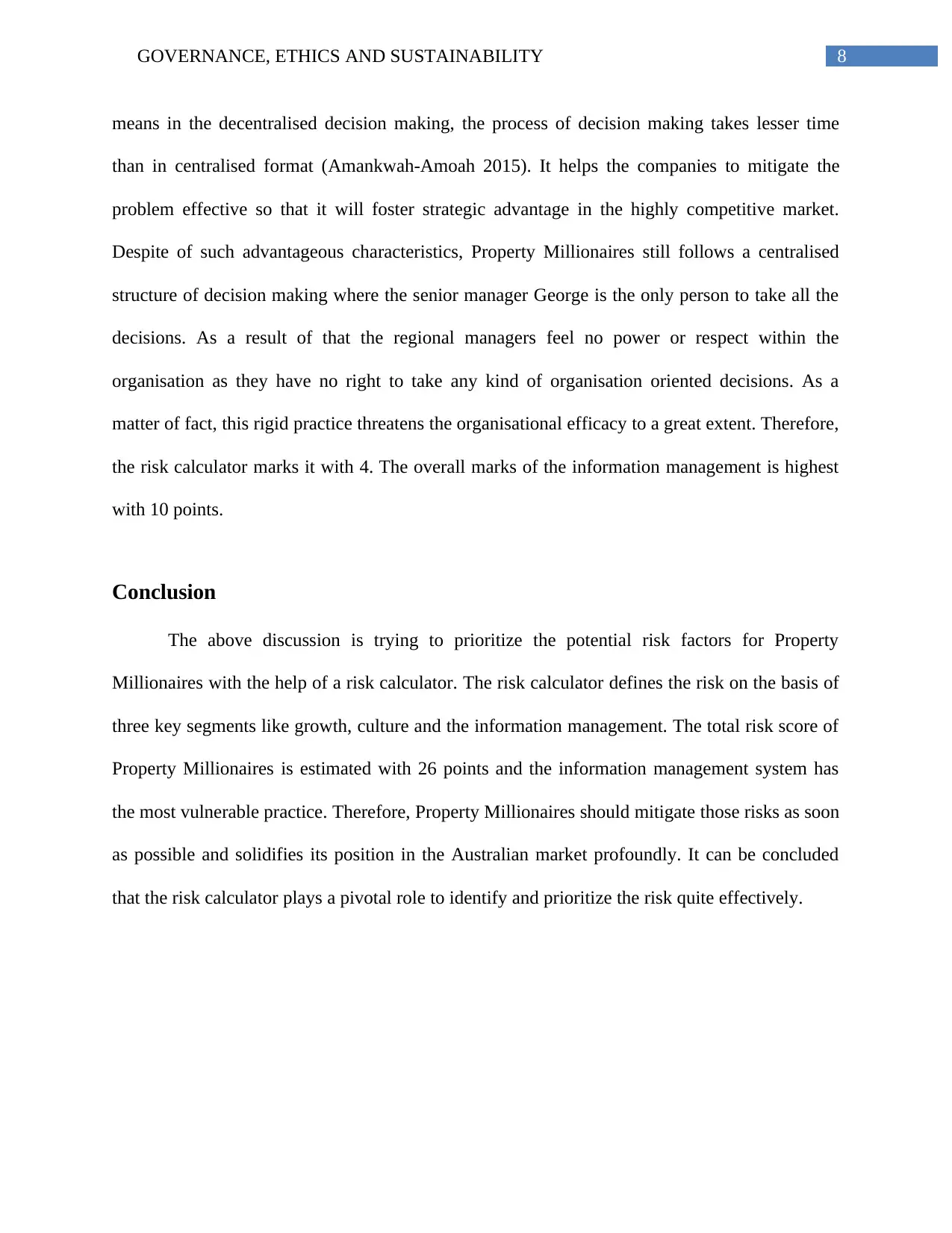
8GOVERNANCE, ETHICS AND SUSTAINABILITY
means in the decentralised decision making, the process of decision making takes lesser time
than in centralised format (Amankwah-Amoah 2015). It helps the companies to mitigate the
problem effective so that it will foster strategic advantage in the highly competitive market.
Despite of such advantageous characteristics, Property Millionaires still follows a centralised
structure of decision making where the senior manager George is the only person to take all the
decisions. As a result of that the regional managers feel no power or respect within the
organisation as they have no right to take any kind of organisation oriented decisions. As a
matter of fact, this rigid practice threatens the organisational efficacy to a great extent. Therefore,
the risk calculator marks it with 4. The overall marks of the information management is highest
with 10 points.
Conclusion
The above discussion is trying to prioritize the potential risk factors for Property
Millionaires with the help of a risk calculator. The risk calculator defines the risk on the basis of
three key segments like growth, culture and the information management. The total risk score of
Property Millionaires is estimated with 26 points and the information management system has
the most vulnerable practice. Therefore, Property Millionaires should mitigate those risks as soon
as possible and solidifies its position in the Australian market profoundly. It can be concluded
that the risk calculator plays a pivotal role to identify and prioritize the risk quite effectively.
means in the decentralised decision making, the process of decision making takes lesser time
than in centralised format (Amankwah-Amoah 2015). It helps the companies to mitigate the
problem effective so that it will foster strategic advantage in the highly competitive market.
Despite of such advantageous characteristics, Property Millionaires still follows a centralised
structure of decision making where the senior manager George is the only person to take all the
decisions. As a result of that the regional managers feel no power or respect within the
organisation as they have no right to take any kind of organisation oriented decisions. As a
matter of fact, this rigid practice threatens the organisational efficacy to a great extent. Therefore,
the risk calculator marks it with 4. The overall marks of the information management is highest
with 10 points.
Conclusion
The above discussion is trying to prioritize the potential risk factors for Property
Millionaires with the help of a risk calculator. The risk calculator defines the risk on the basis of
three key segments like growth, culture and the information management. The total risk score of
Property Millionaires is estimated with 26 points and the information management system has
the most vulnerable practice. Therefore, Property Millionaires should mitigate those risks as soon
as possible and solidifies its position in the Australian market profoundly. It can be concluded
that the risk calculator plays a pivotal role to identify and prioritize the risk quite effectively.
⊘ This is a preview!⊘
Do you want full access?
Subscribe today to unlock all pages.

Trusted by 1+ million students worldwide
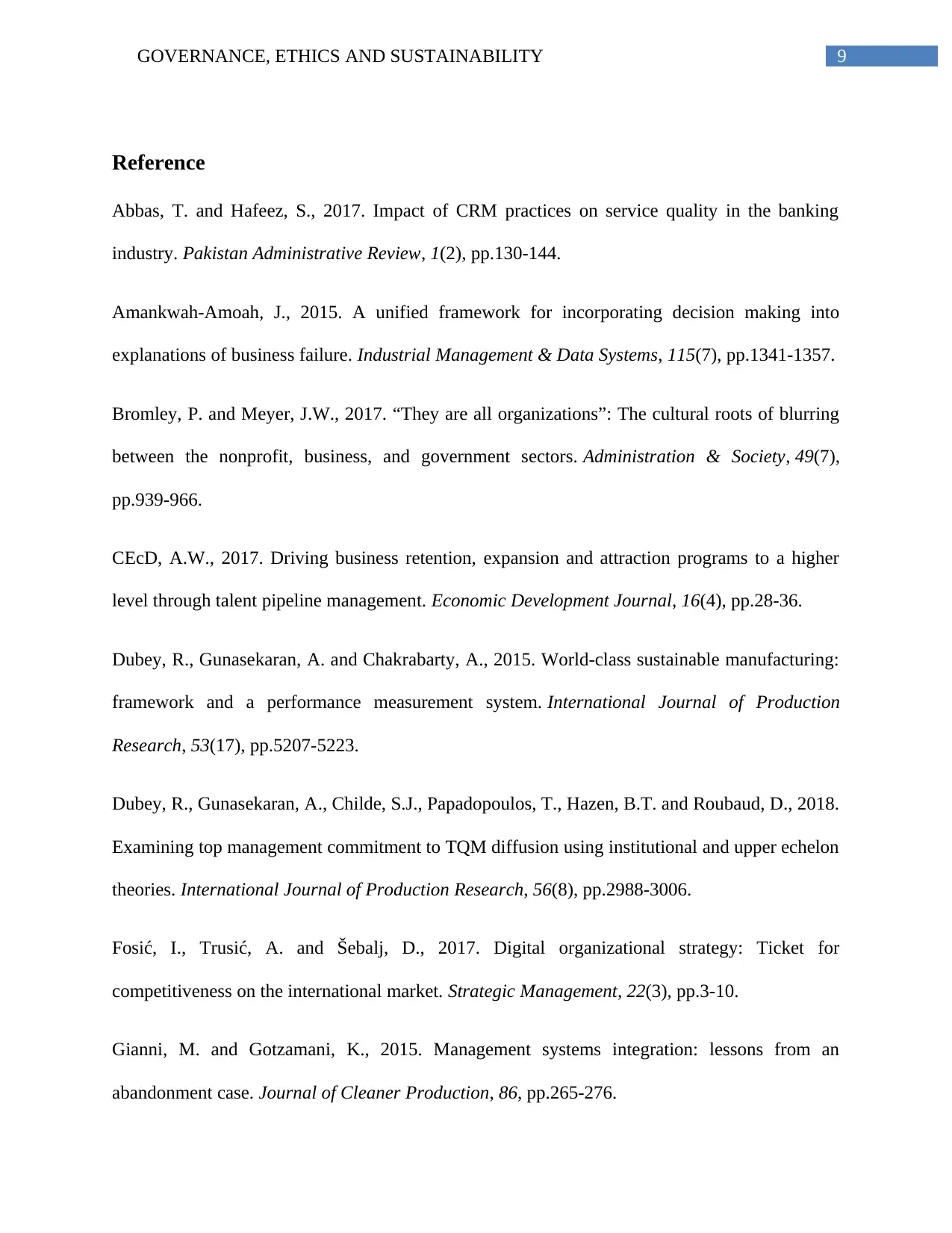
9GOVERNANCE, ETHICS AND SUSTAINABILITY
Reference
Abbas, T. and Hafeez, S., 2017. Impact of CRM practices on service quality in the banking
industry. Pakistan Administrative Review, 1(2), pp.130-144.
Amankwah-Amoah, J., 2015. A unified framework for incorporating decision making into
explanations of business failure. Industrial Management & Data Systems, 115(7), pp.1341-1357.
Bromley, P. and Meyer, J.W., 2017. “They are all organizations”: The cultural roots of blurring
between the nonprofit, business, and government sectors. Administration & Society, 49(7),
pp.939-966.
CEcD, A.W., 2017. Driving business retention, expansion and attraction programs to a higher
level through talent pipeline management. Economic Development Journal, 16(4), pp.28-36.
Dubey, R., Gunasekaran, A. and Chakrabarty, A., 2015. World-class sustainable manufacturing:
framework and a performance measurement system. International Journal of Production
Research, 53(17), pp.5207-5223.
Dubey, R., Gunasekaran, A., Childe, S.J., Papadopoulos, T., Hazen, B.T. and Roubaud, D., 2018.
Examining top management commitment to TQM diffusion using institutional and upper echelon
theories. International Journal of Production Research, 56(8), pp.2988-3006.
Fosić, I., Trusić, A. and Šebalj, D., 2017. Digital organizational strategy: Ticket for
competitiveness on the international market. Strategic Management, 22(3), pp.3-10.
Gianni, M. and Gotzamani, K., 2015. Management systems integration: lessons from an
abandonment case. Journal of Cleaner Production, 86, pp.265-276.
Reference
Abbas, T. and Hafeez, S., 2017. Impact of CRM practices on service quality in the banking
industry. Pakistan Administrative Review, 1(2), pp.130-144.
Amankwah-Amoah, J., 2015. A unified framework for incorporating decision making into
explanations of business failure. Industrial Management & Data Systems, 115(7), pp.1341-1357.
Bromley, P. and Meyer, J.W., 2017. “They are all organizations”: The cultural roots of blurring
between the nonprofit, business, and government sectors. Administration & Society, 49(7),
pp.939-966.
CEcD, A.W., 2017. Driving business retention, expansion and attraction programs to a higher
level through talent pipeline management. Economic Development Journal, 16(4), pp.28-36.
Dubey, R., Gunasekaran, A. and Chakrabarty, A., 2015. World-class sustainable manufacturing:
framework and a performance measurement system. International Journal of Production
Research, 53(17), pp.5207-5223.
Dubey, R., Gunasekaran, A., Childe, S.J., Papadopoulos, T., Hazen, B.T. and Roubaud, D., 2018.
Examining top management commitment to TQM diffusion using institutional and upper echelon
theories. International Journal of Production Research, 56(8), pp.2988-3006.
Fosić, I., Trusić, A. and Šebalj, D., 2017. Digital organizational strategy: Ticket for
competitiveness on the international market. Strategic Management, 22(3), pp.3-10.
Gianni, M. and Gotzamani, K., 2015. Management systems integration: lessons from an
abandonment case. Journal of Cleaner Production, 86, pp.265-276.
Paraphrase This Document
Need a fresh take? Get an instant paraphrase of this document with our AI Paraphraser
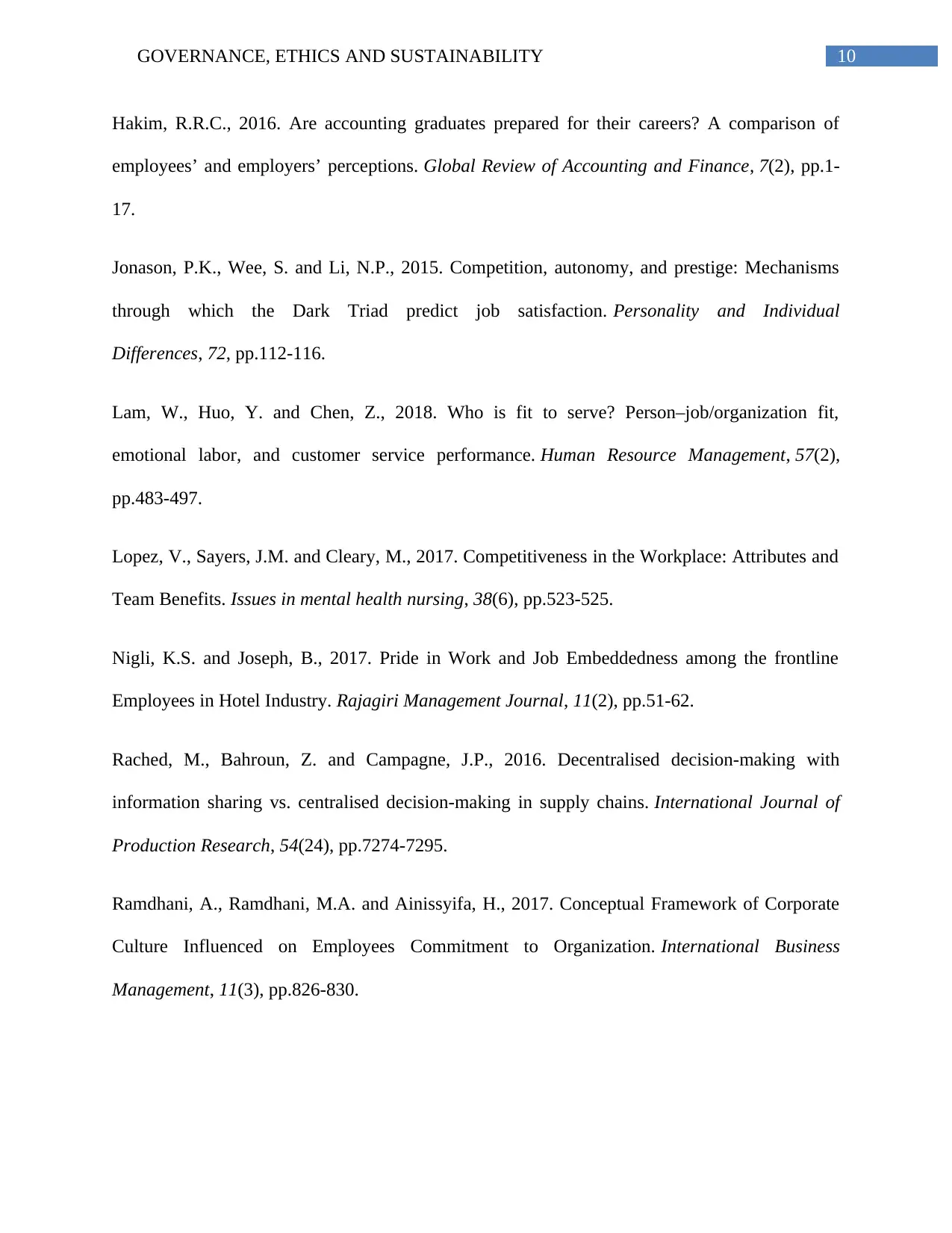
10GOVERNANCE, ETHICS AND SUSTAINABILITY
Hakim, R.R.C., 2016. Are accounting graduates prepared for their careers? A comparison of
employees’ and employers’ perceptions. Global Review of Accounting and Finance, 7(2), pp.1-
17.
Jonason, P.K., Wee, S. and Li, N.P., 2015. Competition, autonomy, and prestige: Mechanisms
through which the Dark Triad predict job satisfaction. Personality and Individual
Differences, 72, pp.112-116.
Lam, W., Huo, Y. and Chen, Z., 2018. Who is fit to serve? Person–job/organization fit,
emotional labor, and customer service performance. Human Resource Management, 57(2),
pp.483-497.
Lopez, V., Sayers, J.M. and Cleary, M., 2017. Competitiveness in the Workplace: Attributes and
Team Benefits. Issues in mental health nursing, 38(6), pp.523-525.
Nigli, K.S. and Joseph, B., 2017. Pride in Work and Job Embeddedness among the frontline
Employees in Hotel Industry. Rajagiri Management Journal, 11(2), pp.51-62.
Rached, M., Bahroun, Z. and Campagne, J.P., 2016. Decentralised decision-making with
information sharing vs. centralised decision-making in supply chains. International Journal of
Production Research, 54(24), pp.7274-7295.
Ramdhani, A., Ramdhani, M.A. and Ainissyifa, H., 2017. Conceptual Framework of Corporate
Culture Influenced on Employees Commitment to Organization. International Business
Management, 11(3), pp.826-830.
Hakim, R.R.C., 2016. Are accounting graduates prepared for their careers? A comparison of
employees’ and employers’ perceptions. Global Review of Accounting and Finance, 7(2), pp.1-
17.
Jonason, P.K., Wee, S. and Li, N.P., 2015. Competition, autonomy, and prestige: Mechanisms
through which the Dark Triad predict job satisfaction. Personality and Individual
Differences, 72, pp.112-116.
Lam, W., Huo, Y. and Chen, Z., 2018. Who is fit to serve? Person–job/organization fit,
emotional labor, and customer service performance. Human Resource Management, 57(2),
pp.483-497.
Lopez, V., Sayers, J.M. and Cleary, M., 2017. Competitiveness in the Workplace: Attributes and
Team Benefits. Issues in mental health nursing, 38(6), pp.523-525.
Nigli, K.S. and Joseph, B., 2017. Pride in Work and Job Embeddedness among the frontline
Employees in Hotel Industry. Rajagiri Management Journal, 11(2), pp.51-62.
Rached, M., Bahroun, Z. and Campagne, J.P., 2016. Decentralised decision-making with
information sharing vs. centralised decision-making in supply chains. International Journal of
Production Research, 54(24), pp.7274-7295.
Ramdhani, A., Ramdhani, M.A. and Ainissyifa, H., 2017. Conceptual Framework of Corporate
Culture Influenced on Employees Commitment to Organization. International Business
Management, 11(3), pp.826-830.
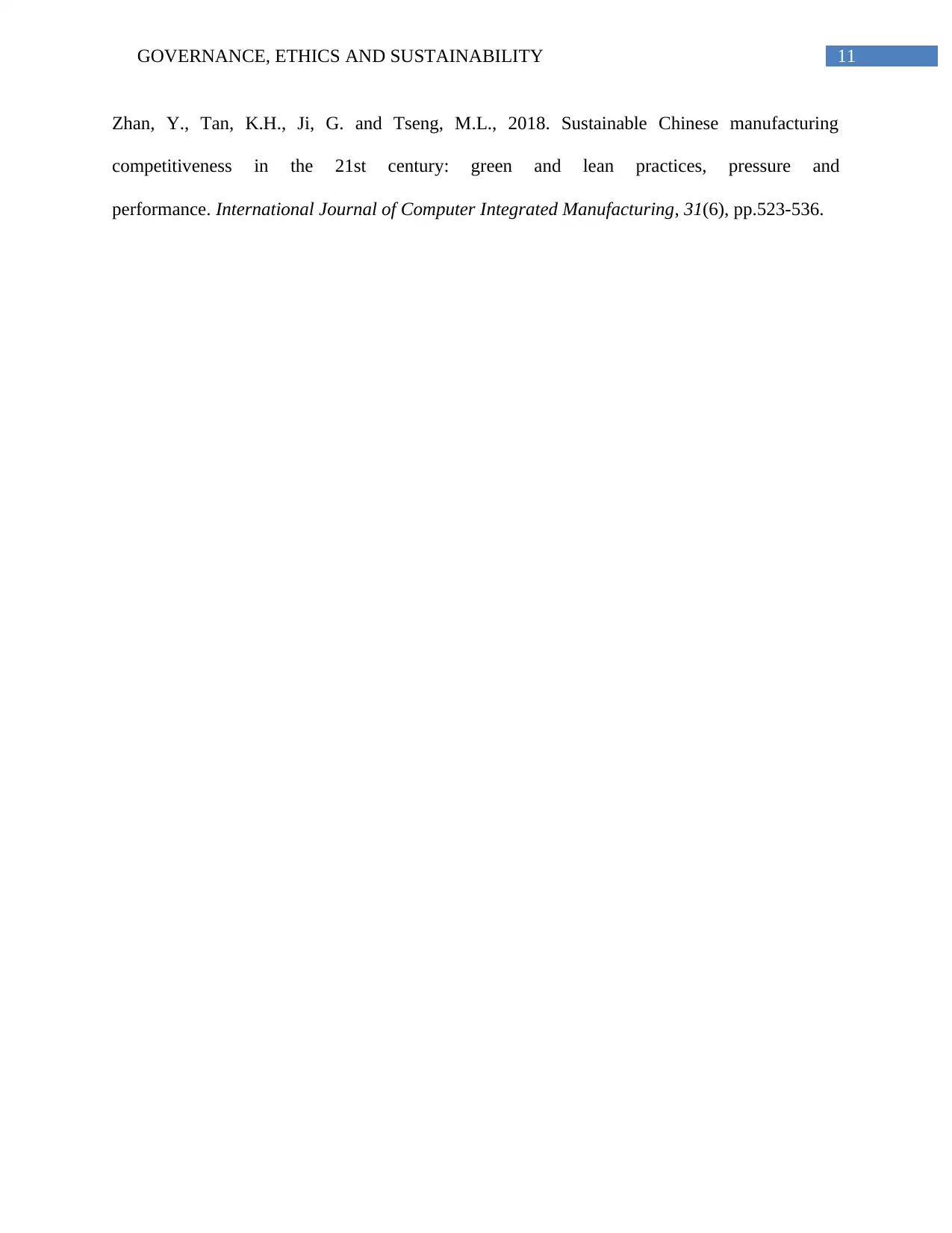
11GOVERNANCE, ETHICS AND SUSTAINABILITY
Zhan, Y., Tan, K.H., Ji, G. and Tseng, M.L., 2018. Sustainable Chinese manufacturing
competitiveness in the 21st century: green and lean practices, pressure and
performance. International Journal of Computer Integrated Manufacturing, 31(6), pp.523-536.
Zhan, Y., Tan, K.H., Ji, G. and Tseng, M.L., 2018. Sustainable Chinese manufacturing
competitiveness in the 21st century: green and lean practices, pressure and
performance. International Journal of Computer Integrated Manufacturing, 31(6), pp.523-536.
⊘ This is a preview!⊘
Do you want full access?
Subscribe today to unlock all pages.

Trusted by 1+ million students worldwide
1 out of 13
Related Documents
Your All-in-One AI-Powered Toolkit for Academic Success.
+13062052269
info@desklib.com
Available 24*7 on WhatsApp / Email
![[object Object]](/_next/static/media/star-bottom.7253800d.svg)
Unlock your academic potential
Copyright © 2020–2026 A2Z Services. All Rights Reserved. Developed and managed by ZUCOL.



